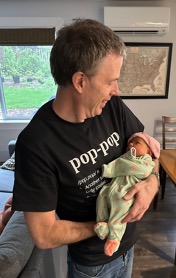Foster Quantitative Methods Faculty Spotlight – Mark Hillier
Get to know Foster’s Associate Professor of Quantitative Methods Mark Hillier, who teaches the core MBA core course Decision Support Models.
Please tell us a bit about your background.
I was born and raised in the Bay Area on the Stanford campus; my dad was a professor there. I was a competitive swimmer from age 5 through college. I attended Swarthmore College for undergrad and then came home for graduate school, earning my PhD at Stanford in Management Science and Engineering. I’ve been at Foster since 1993.
I met my wife on the swim team at Swarthmore, and we have two daughters. My oldest (Sarah) got a Masters in Teaching from UW, and is teaching math in the Snoqualmie Valley school district. She and her husband just had a daughter in May, making me a Pop Pop! My youngest (Jennifer) graduated from Scripps College and is currently working for Epic (medical software company) in Madison, Wisconsin. Sadly, my wife passed away, suddenly and unexpectedly back in 2009, when my girls were teenagers.
 Proud Pop Pop!
Proud Pop Pop!
Some things I enjoy outside of Foster include playing softball (I play for and manage my church softball team in a Bellevue league) and travel (I’ve been to 49 states and over 35 countries). I’m a Disneyland fanatic (I’ve spent 230 days, or over 1% of my life, at a Disney theme park). I am an AFOL (adult fan of lego), both at home and in the classroom. I have built many large sets (Star Destroyer, Yoda, BB8, R2D2, Tower Bridge, Eiffel Tower, Hogwarts, and many more).
 With daughter Jennifer at Disneyland’s Splash Mountain
With daughter Jennifer at Disneyland’s Splash Mountain
An interesting fact about me – I am a direct descendant of the “founders” of Iceland (first permanent settlers in the year 874)—Ingólfr Arnarson and his wife, Hallveig Fróðadóttir. My grandmother was born in Iceland. Also, I spent a year of my childhood in Denmark which is where I picked up the joy of lego (which is based in Denmark).

Mark’s Lego Star Destroyer and TIE Fighter
What excites you about your subject area and what are some of your research interests?
I teach classes in decision modeling—basically, how we can use data and mathematical models to make better decisions. We explore how to set up models within the intuitive environment of an Excel spreadsheet, and then use the tools available within Excel to determine the best decision that optimizes our objective.
This clearly has many applications in business (e.g., portfolio optimization, optimal resource allocation, scheduling, project management). But I find it especially exciting to apply these tools to problems that crop up in everyday life. Some examples where I’ve applied decision modeling to help make better decisions include using a mathematical model to determine the best seating arrangements at my daughter’s wedding reception (so everybody at each table is compatible) and determining the optimal swim team lineup for my college swim team (who swims what race to maximize our odds of winning).
Spreadsheets excite me and math excites me (yeah, I’m a dork). I find it thrilling to creatively put these together to solve problems.
How is your teaching influenced by instructional best practices?
I’m a big believer in active learning (an approach to instruction in which students are asked to engage in the learning process in contrast to “traditional” modes of instruction in which students are passive recipients). One example from class is I use legos to demonstrate an example of determining the optimal product mix. The students each have a mix of raw materials (small and large lego bricks) that can be used to assemble two products (tables and chairs). The optimization problem is to determine how many of each product to produce (tables and chairs) to best utilize the available resources (the various bricks) to maximize profits. The legos make it much easier to visualize the underlying problem which then makes it easier to grasp the underlying mathematical model.
Any tips for future students on how they can brush up on skills/knowledge before taking your course?
My classes make extensive use of spreadsheets (Microsoft Excel). If you are not an Excel expert, it might be useful to brush up on your Excel skills. To assist with this, I have created an online course available to all Foster students called “Foster Excel for Business”. The course includes lessons, each with a short video, practice assignments, and quizzes. If you complete all the quizzes (and perform sufficiently well), you can also earn a “Foster Excel Credential”!
Please tell us briefly about the structure of your course – what can students expect to master by the end of it?
Each week we’ll cover an aspect of decision modeling (through a combination of pre-class videos, in class activities, and post-class videos). But modeling with spreadsheets is best learned by doing. Therefore, each week will also include a problem set to practice the topics covered during the week.
Somewhat unusually, each problem set is done both individually and then also as a team. Every student first attempts to set up and solve each of the problems in the problem set on their own. But it is fine (even encouraged) to discuss and/or get help from classmates throughout this process. I want you to help each other! The individual submissions are only graded for completion. This individual process assures that everyone learns and practices all aspects of every problem, but also can get help from their classmates.
Students then meet in their study teams to compare solutions, clarify issues that were encountered, and streamline the various analyses into a single submission from the team. This is an opportunity to make sure everyone on the team understands the material and everything in the team assignment that is being submitted. The team submissions are graded for accuracy.
What advice do you have for students to ace your course?
Don’t be afraid to ask for help (from either me or your classmates). I view the problem sets as primarily a learning tool rather than an assessment tool. Therefore, I don’t mind you working together, comparing solutions and approaches, and giving each other help. Don’t struggle in solitude. Also, don’t fall behind. The topics tend to build on each other, so if you don’t understand the earlier concepts, this can make the later concepts harder to learn. Don’t wait to get help.
How will students apply the knowledge and skills they gain in your classroom in their careers?
Regardless of your career path, in whatever you do, there are decisions that need to be made. There are applications of decision modeling throughout all areas of business. This class will help you think logically about decision making. What are the decision variables? What are the goals? What are the constraints? How can we structure the problem as a decision model? Then you’ll have the tools needed to optimize the model and make better decisions.

